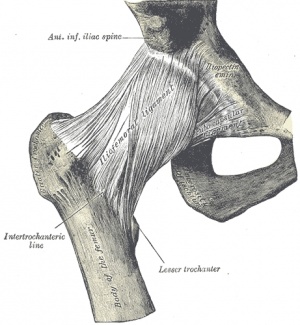Hip Anatomy
|
Original Editor - Your name will be added here if you created the original content for this page. Lead Editors - If you would like to be a lead editor on this page, please contact us. |
Description[edit | edit source]
The hip articulation is true diarthroidal balland-socket style joint, formed from the head of the femur as it articulates with the acetabulum of the pelvis. This joint serves as the main connection between the lower extremity and the trunk, and typically works in a closed kinematic chain.
Motions Available[edit | edit source]
- Flexion: forward and upward movement of the femur at the hip occurs in the sagittal plane about an medial-lateral axis.
- Extension: upward movement toward the rear of the body of the femur at the hip occuring in the sagittal plane.
- Abduction: movement of the femur on the hip in a direction away from the midline of the body in the frontal plane.
- Adduction: movement of the femur on the hip in a direction toward the midline of the body in the frontal plane.
- Internal Rotation: rotation of the femur toward the midline of the body in the transverse plane.
- External Rotation: rotation of the femur away from the midline of the body in the transverse plane.
Ligaments & Joint Capsule
[edit | edit source]
- Ligamentum Teres:
- Ischiofemoral Ligament:
- Iliofemoral Ligament (Y Ligament of Bigelow): Attaches to the AIIS and then fans out to attach along the intertrochanteric line of the femur. The iliofemoral ligament is the strongest ligament in the body, and checks extension, adduction (superior fibers), and abduction (inferior fibers). In addition, because this ligament limits hip extension, it allows maintenance of the upright posture by reducing the need for muscle contractions.
- Pubofemoral Ligament:
Joint Capsule:
- The capsule of the hip joint is strong and is reinforced by strong ligaments, providing a relatively stable joint. Unlike the weak articular capsule of the shoulder, the hip joint capsule is a substantial contributor to joint stability<ref>Levangie P, Norkin C. Joint structure and function: A comprehensive analysis. 4th ed. Philadelphia: The F.A. Davis Company; 2005.</ref>.







